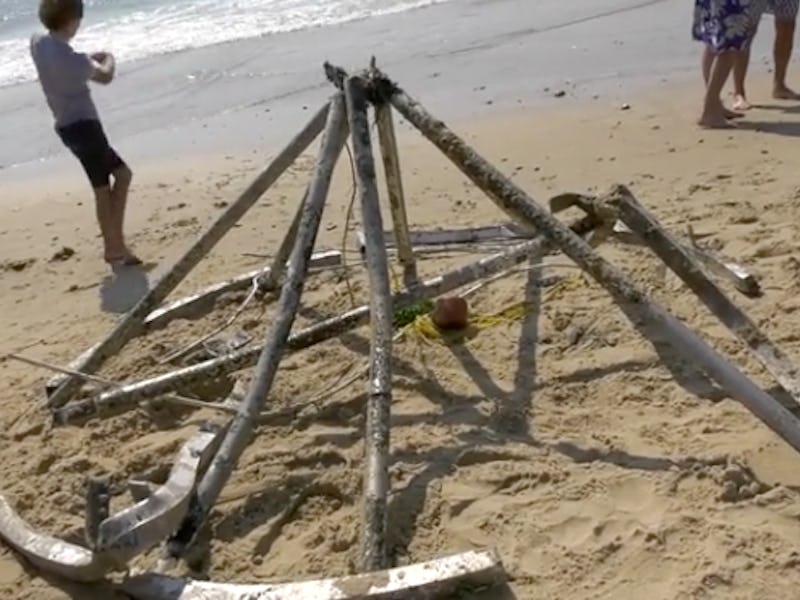The coast of Westerly, Rhode Island, is lined with cheerful beaches and fresh, blue-green waves. In recent years, the biggest news to hit the usually-peaceful beachfront town was the introduction of Taylor Swift, who bought a mansion overlooking the sea in 2013 for $17.75 million. But in late August, a mysterious discovery eclipsed the star’s presence: A huge, bizarre, seemingly eight-legged object was dredged up in the waters behind Swift’s backyard.
The steel and concrete structure, which is about eight to 10 feet in length, was described as “more like the Mars Rover than anything that would be found at the bottom of the ocean” by The Westerly Sun, which first reported the story. When it was discovered in the water, the original plan was to leave it submerged. However, as further discussion raised concerns that it posed a danger to swimmers, local authorities made a plan that led to the object’s excavation on Thursday.
Amid claims that the object is a sunken UFO, scientists from the University of Rhode Island took their best stab at identifying it, suggesting it was an uncharacteristically large piece of marine monitoring equipment.
Pieces of the submerged object were dredged up from the sea on Thursday.
“Our best guess had been that it was the sea base of an acoustic Doppler profiler, which the scientists said are typically 4 or 5 feet long,” said Peter Brockmann, East Beach Association president, in an interview with The Westerly Sun.
It’s a plausible explanation, says Frank Bahr, a research specialist at the Woods Hole Oceanographic Institution’s department of physical oceanography. “I agree that the gizmo looks like a bottom mount for perhaps a sensor,” he said in an e-mail to Inverse.
Jim Culter, a senior scientist at the Mote Marine Laboratory’s Benthic Ecology Program, agrees. Culter, who has experience using acoustic Doppler current profilers (ADCP) — tools used for measuring currents — in coastal estuaries, explains in an e-mail to Inverse that the object could “very well be a bottom mount for an ADCP or other instrumentation as there are many different commercial styles and researchers often fabricate their own mounts for specific purposes.”
An excavation crew dug up the object in pieces on Thursday.
ADCPs are huge tools that, according to NOAA, use a scientific phenomenon called the Doppler shift to measure the movement of currents. To do this, the ADCP needs to be attached to the bottom of the sea floor, where it will emit four beams of high-frequency sound waves into the water. Those sound waves will inevitably bounce back toward the ADCP after knocking into particles in the water, and the characteristics of the return waves can be used to determine how fast the water’s current is moving.
Because they’re so big and usually need to stay put for at least 30 days, they need to be mounted to the sea floor, but the size of their mount depends on the body of water it’s in.
Taylor Swift's multimillion-dollar mansion and its mysterious waters.
“Mounting frames for open ocean are generally more robust than those used in shallow, calmer water,” says Culter, suggesting that the mystery ADCP seems abnormally large because it was designed for the ocean. There are, however, no standard sizes, he says, and customization is common.
How the giant instrument washed up near Swift’s shore, however, is still unclear. Bahr jokes that it might simply be a poorly made mount. “Frankly, it looks a little bit flimsy for a WHOI [Woods Hole Oceanographic Institution] design - our stuff does not just wash up :-) - just kidding, of course it does,” he says, noting that instruments in the violent Atlantic generally need to use heavier mounts that usually involve a heavy ring of solid metal in their base.
Culter’s preference is to use concrete pads, like the diver below.
A diver installs an acoustic Doppler current profiler that is not nearly as big as the thing found behind Swift's house.
It seems the mystery object is not so mysterious after all, although Swift’s neighbors can’t be blamed for wondering about its extraterrestrial aesthetic. After all, very few of us regularly spend time scoping out the machinery at the bottom of the sea, and certainly not in the sea behind her massive mansion.
If she wants someone to blame for all the weird press about the spooky goings-on in her backyard, she should probably take her wrath to folks at the U.S. Geological Survey, the University of Rhode Island’s marine research institution, the Army Corps of Engineers, or any of the other consulting firms conducting coastal surveys or beach restoration monitoring, which Culter says are “typical users of such devices.”
While it may seem that Westerly can ride out the rest of the summer in peace, there always remains the possibility that the scientists are wrong. “Of course it could easily be something totally unrelated to marine research which was blown into or discarded into the ocean,” says Culter. It’s a scary thought, but it might just be that planting this mystery machine is what Swift is referring to as she taunts haters in her new song, “Look What You Made Me Do.”
